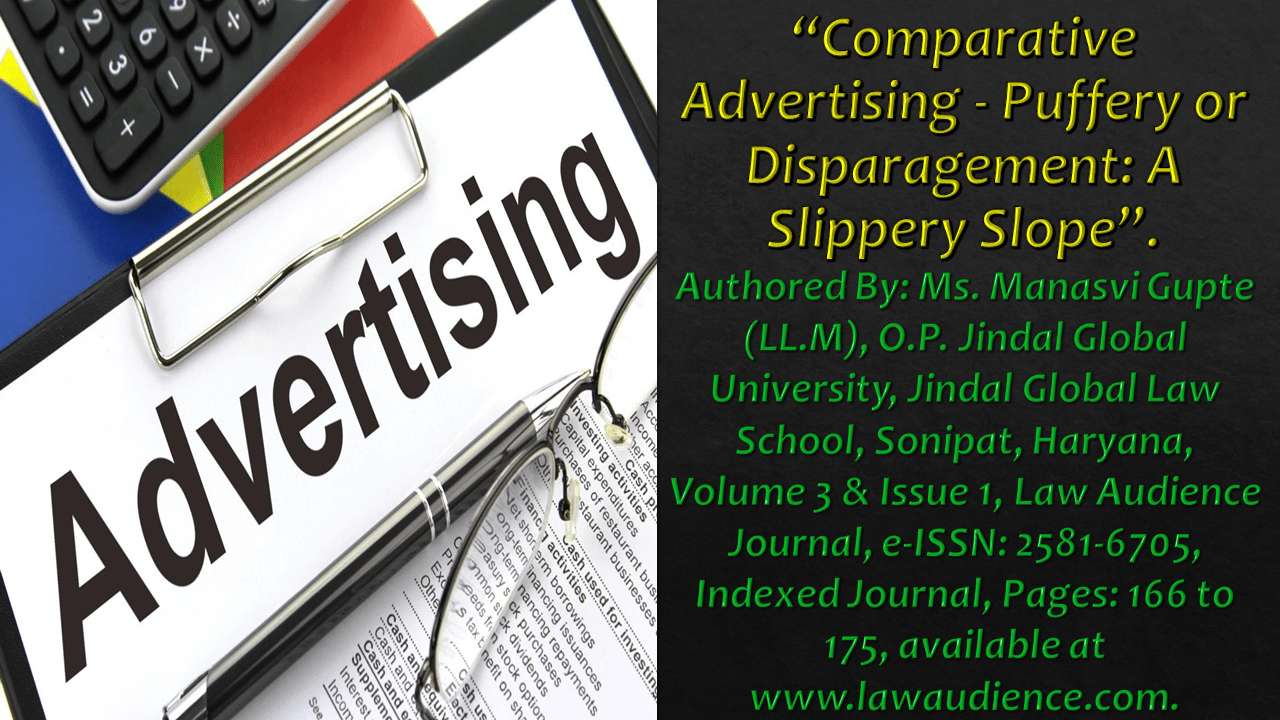Click here to download the full paper (PDF)
Authored By: Ms. Manasvi Gupte (LL.M), O.P. Jindal Global University, Jindal Global Law School, Sonipat, Haryana,
Click here for Copyright Policy.
I. INTRODUCTION:
An Advertisement is a method of communicating features, aspects, and characteristics of a product or service to the end consumers, making the item attractive and desirous for purchasing. Comparative Advertising, a contentious form of advertising, simply pits the attributes of one product in reference to another, having a higher market value.[1] The very idea that lies behind this technique is to showcase to the consumer how one product is superior compared to that of the competitors. However, the question that lies is whether such advertisements result in trademark infringement? The evolution of Comparative Advertisement goes back to the times of commerce, where the quality of one product was compared to the quality of another.[2] Each player in the market has a competitive advantage of manifesting the supremacy of their product over the other players in the market. Therefore, there is a thin line between a Trademark infringement and highlighting the peculiarity of a product, and this thin line has been termed as Product Disparagement.
“Mine is the best, he is no good,”[3] summarizes the intent of disparaging a product. Commercial Disparagement is the assassination of another’s product as being no good.[4] Hence, what surrounds such a form of advertisement is discrediting the mark or product of the competitor by way of delivering false information or proving the product to be faulty or defective.[5] As opposed to Puffery, disparagement is impermissible. Puffery, on the other hand, is simply exaggerating the quality and value of a product or service to make it attractive to the consumer and therefore is not illegal per se.[6]
Unlike The United States, wherein Comparative Advertising is not only permissible but also encouraged by the Federal Trade Commission as an effective source of information to the consumers,[7] Comparative Advertising in India is permissible only to a certain extent under the Trademark Act, 1999. Registering a Trademark casts a psychological impression upon the consumer[8] and acts as a merchandising shortcut.[9] Consumers immediately relate to a well-known mark, its slogan, or logo when making a conscious purchasing choice. The concept of Comparative Advertisement has been developed over the years by judicial precedents under the Trademark regime and has thereby paved the way for further development.
The central aim of the paper is to recognize the thin line between Product Disparagement and Puffery under the Purview of Comparative Advertising and thereby identify the shift in the judicial perspective to formulate uniformity, subject to the Trademark Laws. Part I of the paper will discuss the various statutory provisions that govern Comparative Advertising. Part II will specifically examine the importance of Trademark Regime for Comparative Advertising, and how effectively it manoeuvre the permissible limitations. The Part III of the paper will thereby focus on the various approaches and perspectives adopted by the Indian Courts throughout several years to formulate a sound framework for Comparative Advertising
II. STATUTORY PROVISIONS OF COMPARATIVE ADVERTISING:
The concept of Advertisement stems from Article 19(1)(a) of the Constitution of India, the Freedom of Speech and Expression. However, the ambit of 19(1)(a) failed to recognize advertising as a form of free speech due to its commercial gain. However, the decision of Hamdard Dawakhana vs. UOI[10], was revered by the court in the case of TATA Press vs. Mahanagar Telephone Nigam Ltd,[11] wherein it was recognized that advertisement, as a medium of communication to the consumer, results in numerous benefits for the end-users, by disseminating information pertaining to a good or service and thereby creating greater public awareness.[12] Following this historic judgment of the Supreme Court, an advertisement was brought within the scope of free speech. However, along with Fundamental rights, come greater unjust difficulties.
The Monopolies and Restrictive Trade Practices (MRTP) Act, 1984 (now repealed) was enacted in India to govern unfair trade practices, by way of discouraging monopoly and encouraging competition in the market.[13] The Act enlists a number of unfair practices that are prohibited, one of which is providing false information about a competitor’s product by way of comparative representation.[14] For several years, the decisions pertaining to Comparative Advertising have been consumer-centric, rather than IP centric.[15] Under the MRTP regime, the Delhi High Court dealt with one of the first issues concerning Comparative Advertising in the case of Reckitt & Colman of India Ltd. vs. Kiwi T.T.K. Ltd[16] , wherein the court held that a competitor can claim his product to be the best as compared to his competitors, without defaming, and there shall lie no action of defamation or unfair trade practices, for the simple reason that exaggerating the quality of own product does not amount to unfair trade practices.
Although the concept of Comparative Advertisement was prevalent under the regime of Competition law, it was only after the enactment was the amendment of 2002 of the Trademark Act, 1999 that the principle was incorporated in the IPR jurisprudence. After the MRTP Act was repealed by way of Section 6 of the Competition Act, 2003, Comparative Advertising has been particularly discussed under the Trademark Act, 1999. The said Act provides an exclusive right to the IP holder to prevent competitors from using the same product and thereby has evolved over the years to govern an array of rights concerning various marks.[17] Section 30 of the Act makes Comparative Advertising lawful so long as it is in accordance with honest practice, however, Section 29(8) incorporates certain permissible restrictions, namely, that the advertisement must not be contrary to honest practice or must not be detrimental to its distinctive character or reputation of the trademark.
In the case of Pepsico Inc. vs. Hindustan Coca Cola Ltd.[18], The Delhi High Court for the first time also dealt with IPR laws, along with the provisions of Competition laws. The petitioner filed a suit against the defendants for infringement, however, the court was of a differing view. It was held that in order to identify infringement in a suit for disparagement, the court has to determine three factors, namely, the manner of the commercial, the intention, and the overall message and manner of the storyline and thus concluded first factor as detrimental and thereby held that there was no sign of disparagement in the advertisement. They went ahead to state that the mere declaration of one’s product being better than the competitor does not in itself amount to infringement of the trademark.
Furthermore, in addition to the MRTP Act and the Trademark Act, the Advertising Standards Council of India in its Code for Advertisement deals with Comparative Advertising. The Advertising Council of India (ASCI), established in the year 1985, is a self-regulating body in Advertising for the benefit and protection of consumers and their interests.[19] Under the purview of the code, it allows advertisements for the benefit of healthy competition in the market by way of comparison with other products within the market, provided that such comparison is made based on factual accuracy and is capable of being substantiated, and must not thereby attack or discredit the products of another player in the market.[20]
III. COMPARATIVE ADVERTISING UNDER THE TRADEMARK REGIME:
Intellectual Property laws and Competition laws have been in a tussle with each other from the time both these statutes were enacted due to their different approaches towards right and monopoly. However, after the legalization of Comparative Advantage in India, to benefit the consumer by imparting particular information about certain goods and services in comparison to others, and thereby increasing public awareness, the intent of both these laws is intertwined. This means that for the purpose of adjudicating the permissible limits of Comparative Advertisement both statutes have common goals, which is to avoid Product Disparagement.
The Trademark Act,1999 provides for the registration of certain marks which sets them apart from other competitors. These marks, once known to the consumers, acts as a distinct identity that the end users can connect with. Therefore, to make the mark known to the public, the most effective tool is Advertisement. Catchy slogans and color schemes, along with a sing-along background score facilitates the consumer to associate the mark and connect with it through a feeling, which acts as a solid Goodwill for the company. This Goodwill in turn contributes into building a customer base. Over the years, due to an increase in Globalisation and various platforms for communication, the threat of distinguishing one mark from the other has become a tedious task due to the increase in competition and creativity. Therefore, advertisers came up with an alternative technique to highlight their features and characteristics by comparing their product to that of the others in the market. Although the technique of comparative advertising was an effective tool to attract an audience, it also gave rise to an increase in trademark infringement suits. Advertisers failed to identify the thin line between Puffery and Disparagement leading to defaming the Marks of other proprietors.
Despite its downfalls, Comparative Advertisement was legalized within the purview of the Act, but only to a certain extent. The permissible limitations are enshrined under Section 30 of the Trademark Act, namely honest practice and not being detrimental to the distinctive character of a trademark. Although the ambit of honest practice has not been defined anywhere under the statute, it is said to be hybrid derived from The Paris Convention (Article 10) and Trademark Directive of European Union (Article 4 & 5), wherein it is provided what does not amount to honest practice, that is ‘any use of a sign without due cause takes advantage or is detrimental to the reputation of a trademark.’[21] Hence, it can be said that both the limitations are in a way entwined together; any detrimental comparison between two rivals’ products is bound to be dishonest.[22]
Therefore, if Comparative Advertising results in defaming another product, it will first lead to unfair trade practice, by way misleading the customer with falsity, but most importantly result in a trademark infringement. This is because a proprietor builds his goodwill and reputation around a mark, by way of Advertisements, schemes, quality, and distinct features. The act of discrediting others may severely impede their Trademark, thereby infringing their IP right. The development of Comparative Advertising has witnessed a turmoil of differing judicial approaches, although the courts have by way of their recent judgment sided with consumer interests by keeping in view the parameters incorporated under the Trademark Law.
IV. THE JUDICIAL PERSPECTIVE:
As discussed herein-above, there is a thin line between Puffery and Disparagement which is often crossed whilst commercially representing a brand. For several years, a comparative advertisement was given a leeway under the name of Puffery[23] as also observed in the Pepsico Case.[24] However, by means of various approaches over the years, the courts have managed to formulate margins to adjudicate permissible limitations under Comparative Advertising.
In the case of Dabur India Ltd vs. Emami Ltd[25], the court concluded Comparative Advertisement permissible to the extent that it does not ridicule or criticize another mark, in addition to which the court also observed that a case of infringement may occur in the circumstances where there is no specific mention of a product or mark in particular, but a general reference to an entire class of goods, and therefore may come under the purview of disparagement. This case was decided by the court during the pre-trademark era. Furthermore, while adjudicating the case of Dabur India Ltd vs. Wipro,[26] the court failed to establish any standards or formula to identify disparagement, however blatantly went on to hold that disparagement of a product may easily result in defamation, and the court only under such circumstances will interfere in the matter and would otherwise refrain.
Nonetheless, the extent of what comprises honest practices within the purview of Section 30 (1) of the Trademark Act, 1999 was discussed in Godrej Sara Lee Ltd vs. Reckitt Benckiser (I) Ltd.[27] The court held that an advertiser has the right to boast about his goods as compared to that of the competitors by way of making known their technological superiority. The act of an advertiser simply expressing what his products can do, as compared to the competitors will not under any circumstances amount to disparagement.
A shift in the judicial approach was highlighted in the case of Colgate Palmolive Ltd vs. Anchor Health and Beauty Care Pvt Ltd,[28] wherein the court for the first time took into consideration consumer interest and highlighted the need and importance of consumer protection. It was held that Puffery, as a form of advertisement is a beneficial tool for consumers to identify the best-suited product. However, rebuffed the idea of putting forth untrue claims about products to deceive the consumers. The court called for attention towards the importance of consumer education, and how Puffery between two rivals in a market would only lead to confusion and false dissemination of information, completely negating the goal of consumer protection, and thereby leading to antitrust practices and disparagement.
However, the limitations pertaining to Comparative Advertising were truly identified after the landmark judgment of Dabur India Ltd vs. M/s Colortek Meghalaya Pvt Ltd[29], which changed the landscape of the law surrounding Comparative Advertisement. Prior to this case, advertisers could claim their products to be better than other players in the market, although the claims made through the advertisement were false and bogus. The Court, in this case, identified the limits of commercial speech by referring to the case of TATA Press vs. MTNL[30], wherein it was held that under the purview of Article 19(1)(a), freedom of speech is not available to any person, who by way of false information advertises its product. Hence, any person making a false claim even for his product, without the presence of factual evidence, is said to have committed disparagement.
One of the more recent cases concerning Comparative Advertising and product disparagement is Havells India Ltd & anrs vs. Amritanshu Khaitan[31]. The court laid down two tests, inclusive of the standard used to determine whether Comparative Advertising falls within the purview of Puffery or Disparagement, namely, the Test of Honest Advertising and the Test of Misleading Advertisement. It was further held that an Advertiser highlighting only ‘honest’ features of its mark, making it distinct and desirable for the consumers to purchase, will not amount to disparagement. This means that any advertisement displaying false or misleading information relating to their product or even disseminating fallacious information relating to another product with an intention of defaming will amount to disparagement.
Another important case recently decided by the courts is Hindustan Unilever Limited vs. Gujarat Cooperative Milk Marketing Federation & Ors[32], where the court held that the Fundamental Right guaranteed under Article 19(1)(a) cannot be abused with an intention to discredit, malign the mark of a rival by way of Comparative Advertisement. The court concluded by stating that, any advertisement which discredits a class of products or goods affects every manufacturer which is registered under that class. Therefore, any registered Trademark Owner under the discredited Class of Goods has the right to file for an infringement under the Trademark Regime for disparagement. Moreover, an advertiser can within its exclusive right puff its product or mark, but cannot damage the reputation of any other specific or general mark.
In order to test whether the use of a Comparative mark is honest, the court must objectively view it through the lens of a reasonable audience, this was observed in the case of Horlick Ltd vs. Heinz India Pvt Ltd.[33] The judicial approach towards Comparative Advertisement has witnessed a gradual change from competition centric to consumer-centric, taking in view the provisions enshrined under the Trademark regime as guiding light towards determining the parameters of Puffery and Disparagement under the purview of Comparative Advertisement.
V. CONCLUSION:
The most central aspect for any market to function smoothly is the presence of healthy competition in the market, and Comparative Advertising is an effective marketing tool to ensure both competition and public awareness. However, this form of advertising is only permissible up to a certain extent in India, as opposed to the laws of the U.K, wherein Comparative Advertising is permitted so long as the information is true, and supported with proper evidence, even though the advertisement is disparaging in nature.[34] Although, under the Indian Context permissible limitations to this form of advertising are justified keeping in view the rights owned by an IP holder in respect of his trademark.
Nonetheless, the laws pertaining to Comparative Advertising have had a rocky start, with uncertainty about not just the interpretation but also the statute to be adopted to effectively tackle the issues at hand. Although, despite the downfalls, the Trademark regime has altogether managed to stabilize and bring uniformity in the laws. Yet, the question that remains is, whether the parameters discovered are enough to curtail the infringement?
“Too many cooks, spoil the broth.” The concept of Comparative Advertising has been overlapped and intertwined with so many statutes and rights, altogether making the lines blurry, in addition to a lack of clarity of definitions and interpretations.
However, despite this, the Indian courts have over the years built a foundation and paved the way for further development under the Trademark Act, 1999, pertaining to a conclusive framework for Product Disparagement and Puffery under the purview of Comparative Advertising.
Footnotes:
[1] Ngwako Hamilton Maenetje, ‘Comparative Advertising’, Juta’s Bus L 7, 157.
[2] Sudeep Chatterjee and Archana Sahadeva ‘Comparative Advertising: An Overview’, World Intellectual Property Review, (1 September 2013) <https://www.worldipreview.com/article/comparative-advertising-an-overview>.
[3] Saadiya Suleman ‘Comparative Advertising, Disparagement and Trademark Infringement: An Interface’ SSRN Electronic Journal.
[4] Id.
[5] Ian S Blackshaw and Gillian Hogg, ‘Comparative Advertising and Product Disparagement’ Tolley’s J Media L & Prac 13, 294.
[6] M.T. Wroblewski ‘What Is Puffery in Advertising?’, Chron, (17 September 2020) <https://smallbusiness.chron.com/puffery-advertising-24357>.
[7] Charlotte J. Romano ‘Comparative Advertising in the United States and in France’ Northwest J Intl Law Bus, 25, 371.
[8] Albert Robin and Howard B Barnaby Jr, ‘Comparative Advertising: A Skeptical View’ Trademark Rep, 67, 358.
[9] Id. at 3.
[10] Hamdard Dawakhana V. UOI (1960) S.C 11 (1960) AIR 554.
[11] Lawrence Linag and Manav Nagaraj, ‘Tata Press Ltd v. Mahanagar telephone Nigam Ltd. JT 1995 (5) SC 647’ (1996) 230.
[12] Parth Gokhale and Shriyani Datta, ‘Comparative Advertising in India: Evolving a Regulatory Framework’ NUJS L Rev,4, 133.
[13] Swaraj Paul Barooah Shivaji Bhattacharya ‘Comparative Advertising: Balancing Consumer Interests vis-a-vis IPR Infringement’ Indian J. Intell. Prop. L 116.
[14] M.R.T.P Act 1984, S. 36A.
[15] Id at 8.
[16] Reckitt & Colman of India Ltd. v Kiwi T.T.K. Ltd (1996) HC Delhi 292 (1996) DLT 29.
[17] Stacey L Dogan and Mark A Lemley, ‘Grounding Trademark Law through Trademark Use’ Trademark Rep, 98, 1345.
[18] Pepsico Inc. V. Hindustan Coca Cola Ltd, (2003) HC Delhi 27 (2003) PTC 305.
[19] The Advertising Standards Council of India (ASCI),Indian Broadcasting Foundation, <https://www.ibfindia.com/advertising-standards-council-india-asci>.
[20] Nupuar Kumar ‘Comparative advertising – Acceptable competitive behaviour and law of disparagement’,LKS (19 June 2015) <https://www.lakshmisri.com/insights/articles/comparative-advertising-acceptable-competitive-behaviour-and-law-of-disparagement#>.
[21] Prof. A Afzal Wani and Mrs. Shikha Sharma ‘Comparative Advertising: Problems and Potentials under Trademark Law in India’ Intl JL Juris. Studies ,3.29.
[22] Id.
[23] Biplab Kumar Lenin† and Arun Babu ‘Comparative Advertising and the Consumer – Changing Dynamics’JIPR, 22, 113.
[24] Id. at 18.
[25] Dabur India Ltd V. Emami Ltd (1996) Del 29 (1996) PTC 1.
[26] Dabur India Ltd V. Wipro (2006) Ban. 32 (2006) PTC 677.
[27] Godrej Sara Lee Ltd V. Reckitt Benckiser (I) Ltd (2006) HC Del 32 (2006) PTC 307.
[28] Colgate Palmolive Ltd V. Anchor Health and Beauty Care Pvt Ltd (2009) Mad 40 (2009) PTC 653.
[29] Dabur India Ltd V. M/s Colortek Meghalaya Pvt Ltd (2010) Del. 42 (2010) PTC 88.
[30] TATA Press V. MTNL (1995) SC 5 (1995) SCC 139.
[31] Havells India Ltd & anrs V. Amritanshu Khaitan (2015) Del 62 (2015) PTC 64.
[32] Hindustan Unilever Limited V. Gujarat Cooperative Milk Marketing Federation & Ors (2017) Bom 204 (2017) L 5.
[33] Horlick Ltd V. Heinz India Pvt Ltd (2017) Del. 808 (2018) COMM.
[34] Id. at 11.
Cite this article as:
Ms. Manasvi Gupte, Comparative Advertising – Puffery or Disparagement: A Slippery Slope, Vol.3 & Issue 1, Law Audience Journal, Pages 166 to 175 (16th June 2021), available at https://www.lawaudience.com/comparative-advertising-puffery-or-disparagement-a-slippery-slope/.



